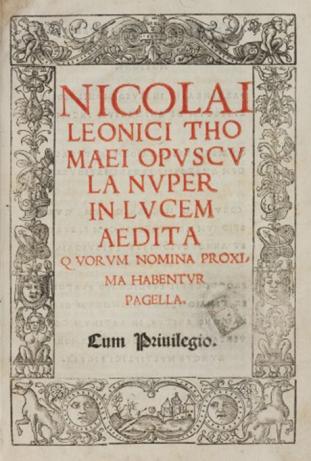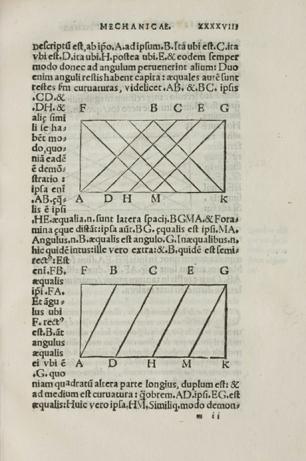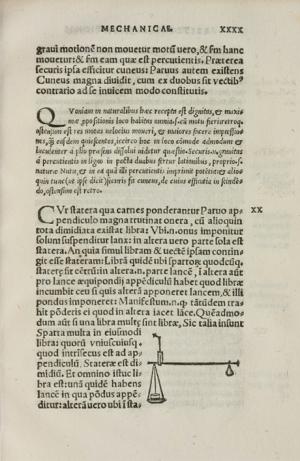The Aristotelian Mechanics enjoyed immense popularity upon its rediscovery in the early modern period. Translations of the Greek text in Latin or vernacular languages were made, as well as paraphrases and extended commentaries. Of particular importance for the early modern spread of mechanics is the Latin translation of the Quaestiones Mechanicae (QM) 1525 by the Italian humanist Niccolò Leonico Tomeo (1456–1531) (Fig. 1). Although Tomeoʼs QM was not the first Latin translation of the Mechanics, it became the text’s most popular version in the sixteenth century, and was accompanied by Tomeoʼs explanatory comments and diagrams to render its difficulties more accessible. In making these changes Tomeo paved the way for future commentators, who frequently used his work as a basis for their own expositions. My current research project – incidentally coinciding with the 2400th year since Aristotle’s birth – focuses on preparing a new edition of Tomeoʼs QM for the Edition Open Sources, including a commentary setting out Tomeoʼs translation project and his interpretation of the text.
Tomeo is mostly renowned for his teaching of Aristotle, at the University of Padua, directly from the Greek text; he was proficient in both Greek and Latin. His aim was to establish a sound textual basis of the Aristotelian Mechanics by paying attention to alternate readings and offering textual remarks. Along with the printed text of the QM published in Venice, a manuscript in the Vatican Library contains two different versions of the Latin translation. Codex Vat.Reg.Lat. 1291 written by the hand of Tomeo, reveals several stages of revisions in the Latin text in advance of the printed edition. Tomeo employed similar procedures for the Greek text, when he aimed to establish the original version of the Mechanics, visible in the manuscript Bern. 402, copied by Tomeo himself and emended after its completion. Tomeo also added diagrams in the margins of the text that underwent several transformations before finally being adopted in the QM. These sources provide evidence of Tomeoʼs practices as an editor and translator of ancient scientific texts, and offer a unique insight into the steps of his translation project.

Figure 1: Front matter of Leonicus Thomaeus, Nicolaus: Opvscvla nvper in lvcem aedita qvorvm nomina proxima habentvr pagella: cum priuilegio, 1525; ECHO Cultural Heritage Online.
In codex Bern. 402, Tomeo included a set of instructions for his Latin translation. He marked for example those passages that he considered to be later additions; consequently, these passages were omitted from the Latin manuscript and print. In his translation Tomeo remained faithful to the Greek text, which is visible in that he preferred to use transliterations of Greek technical terms rather than looking for Latin equivalents. The different versions of the Latin translation further display accurate revisions by Tomeo before the printing of the text in 1525. While for the text of the Mechanics Tomeoʼs aim was strictly philological – to present a reconstruction of the original text along with a literal translation in Latin – he used the diagrams as a means to extend and comment on the text. He included diagrams that were not prescribed by the author, and inserted additional diagrams representing his own interpretations of the mechanical questions. Problem 25 of the Mechanics, for example, describes the cording of ancient beds: the description of the Greek text is defective and displays at best the various principles of cording, either along the diagonal of the bed or from one side to the other. Tomeoʼs Latin translation follows the corrupt Greek text, but we notice that he added some diagrams of actual beds from his own experience (Fig. 2).

Figure 2: Leonicus Thomaeus, Nicolaus (1525), p. 48; ECHO Cultural Heritage Online.
Such diagrams constitute a commentary on the text, and at the same time shed light on the context of the mechanical discipline in the sixteenth century. Apart from including new and original diagrams in his Latin translation of the Mechanics, Tomeo employed varying diagrammatic practices when we compare his Greek manuscript with the printed book. Some of the diagrams have lost their relevance in relation to the text – they no longer form part of a geometrical proof, for example, on the functioning of a balance but are very loosely connected with the surrounding text, now only illustrating a certain type of balance (Fig. 3). This altered status of some of the diagrams is further enforced by the use of three–dimensional effects and shading. Interestingly, the diagrams contained in the manuscript from the Vatican Library show that Tomeo himself devised the diagrams for the 1525 print. While he had a range of diagrammatic practices at his disposal, Tomeo made a conscious decision to turn some of the diagrams into pictures. An important research question, which I am now considering, is to what extent the text-image relationship depends on the medium, and especially how early modern authors structured their arguments differently when working in manuscript or print.

Figure 3: Leonicus Thomaeus, Nicolaus (1525), p. 40; ECHO Cultural Heritage Online.
The different types of diagrams in Tomeoʼs Latin translation, and in early modern treatises on mechanics in general, can be explained by the specific sixteenth–century interest in the Aristotelian Mechanics. Whereas the ancient treatise is known as the first theoretical treatment of machines, the early modern interest specifically involves practical concerns and lies at the intersection of theoretical and practical knowledge. It is therefore not surprising that we find images and pictures of machines and other mechanical devices in addition to geometrical diagrams. Tomeoʼs translation of the Mechanics presents us with a good example of how Aristotelian knowledge was adapted to a specific context and was altered according to the needs and interests of a later time. As such, my research will contribute to the Department I project “Aristotelization of the World,” which aims to examine the fundamental role played by Aristotelian knowledge in the history of the sciences over time. After a series of workshops at the MPIWG on Aristotelian traditions from antiquity to the Byzantine period the next stage of the project will bring the discussion on Aristotelianism out into the open, including interviews with experts on the spread and transformation of various aspects of Aristotleʼs natural philosophy. Beginning with a focus on Aristotelianism in antiquity and late antiquity, the discussion will be widened to eventually encompass a history of Aristotelian knowledge.
